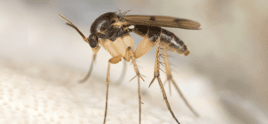Get a free estimate
If you have questions about our services, plans, or pricing we are here for you. Fill out the form below and we will communicate with you by email (and of course provide you with a free estimate).
MARCH 02 2022 /
If you are finding small flies infesting your house plants, chances are good that they are fungus gnats.
These little gnats, which are also called dark winged fungus gnats, are often mistaken for fruit flies, but they actually look more like tiny mosquitoes.
They have slender legs and long antennae that are longer than their head, and light gray to clear wings. Adult fungus gnats are only about 1/16 to 1/8 of an inch long.

Because the adults of these gnats are attracted to light, you may first notice these pests flying around on the insides of exterior windows. But they are relatively weak fliers and usually don't move around much.
Typically they will stick close to potted plants and rest on or run across growing media, compost, foliage, or wet mulch.
When females lay approximately 200 eggs in moist soil, larvae soon appear. These have shiny black heads and elongated, white or clear legless bodies.
Although these gnats have a relatively short lifespan, they multiply quickly and continually; and if the larvae are abundant enough, they will leave slime trails on surfaces that look like the trails small snails or slugs leave behind.
Although these can be a nuisance to have around, adult fungus gnats are not harmful to people, pets, belongings, or even houseplants. But their larvae can be a different story.
If their numbers are large enough, they can damage roots and stunt the growth of the plants they are infesting. And if the damage is severe, fungus gnat larvae can cause plants to die.
If you observe a houseplant that is wilting, it may not be because of lack of water. It may have roots that are being compromised by fungus gnat larvae.
These pests can be extremely difficult to completely get rid of, short of removing all sources of moist organic material.
But it is possible to reduce their numbers by allowing breeding surfaces to completely dry between watering's.
If you allow the top 1 to 2 inches of soil to dry, this will decrease the survival rate of any eggs that have been laid there. But if you want to avoid the headache of a recurring problem with these household pests, the best course of action is to contact American Pest.
Here at American Pest, we only use products that have been thoroughly checked by the EPA and our expert pest technicians are highly trained in exterminating with common household pests you may be dealing with.
Protect your household plants from these pesky, potentially dangerous gnats and keep them beautiful with help from American Pest.